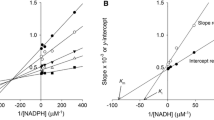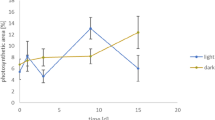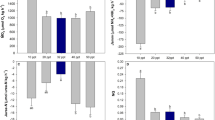Abstract
The freshwater oligochaete Tubifex shows several mechanisms of metabolic adaptations, enabling the worms to occupy saprobial habitats of extremely variable oxygen content. Under normoxic conditions the metabolism of the worms is mainly aerobic with a respiratory ratio of 0.7. Under hypoxic conditions, metabolism of energy sources via aerobic and anaerobic pathways is observed. During complete anoxia acetate and propionate are the main products of glycogen degradation and they are excreted in constant rates into the water. A retransfer of the worms to aerobic conditions enables them to regain aerobic metabolic state within about 60 min.
In two Tubifex habitats, which we have characterized, concentrations of dissolved organic material (DOM) were low in the surface water, but high in the interstitial water from sediments. The short-chain fatty acids acetate and propionate reached concentrations up to 1 mmole/liter. Employing radioisotope techniques, we demonstrated that Tubifex can achieve an integumentary uptake of acetate and propionate from artificial tap water at naturally occurring concentrations of 5 to 1000 μM. Levels of uptake (600 to 800 nmoles/g wwt.hr) and transport characteristics are very similar to those of marine invertebrates associated with detritus rich sediments. The uptake is susceptible to inhibition by structurally analogous compounds and to metabolic inhibition. Furthermore, DOM uptake in Tubifex is susceptible to inhibition by oxygen depletion, ouabain and Na+-depletion. The results may suggest that a carrier system for DOM transport exists in the integument of the worms. The uptake system is highly specific for aliphatic C2 and C3 carboxylic acids. The absorbed volatile fatty acids are rapidly metabolized. Only 15 min after absorption, a considerable amount of radioactivity is present in the glycogen storage of the animals. Depending on the substrate concentration assumed to be available for uptake, up to 40 per cent of the oxidative requirement of the worms may be attained by using dissolved organic material from the interstitial water of their habitat.
Supported by the Deutsche Forschungsgemeinschaft (Ho 631/9-9).
Similar content being viewed by others
References
Graef H., 1985. Das jahreszeitliche Wachstumsgeschehen bei, Tubifex tubifex unter dem Einfluß von extremen Unweltbedingungen. Verb. Dtsch. Zool. Ges. 78: 322.
Hipp, E., 1985. Die Bedeutung von Acetat and Propionat im Energiestoffwechsel von Tubifex sp. Dissertation, Universität Ulm, FRG.
Hipp, E. U. A. Sedlmeier & K. H. Hoffmann, 1984. Aerobic metabolic trends after anoxia in the freshwater oligochaete Tubiflex. Comp. Biochem. Physiol. 78B: 125–129.
Hipp, E. T. Mustafa, U. Bickel & K. H. Hoffmann, 1986a. Integumentary uptake of acetate and propionate (VFA) by Tubifex sp., a freshwater oligochaete. 1. Uptake rates and transport kinetics. J. exp. Zool. 240: 289–297.
Hipp, E., U. Bickel, T. Mustafa & K. H. Hoffmann, 1986b. Integumentary uptake of acetate and propionate (VFA) by Tubifex sp., a freshwater oligochaete. II. Role of VFA as nutritional resources and effects of anaerobiosis. J. exp. Zool. 240: 299–308.
Hoffmann, K. H., 1981. Phosphagens and phosphokinases in Tubifex sp. J. Comp. Physiol. 143: 227–243.
Mustafa, T, J. Seuß, J. B. Jorgensen & K. H. Hoffmann 1983. Gluconeogenesis in facultative anaerobic invertebrates: Evidence of oxalacetate decarboxylation and anaerobic end product incorporation into glycogen from the tissues of Tubifex sp. J. Comp. Physiol. 149: 477–483.
Seuß J., E. Hipp & K. H. Hoffmann, 1983. Oxygen consumption, glycogen content and the accumulation of metabolites in Tubifex during aerobic-anaerobic shift and under progressing anoxia. Comp. Biochem. Physiol. 75A: 557–562.
Seuß J. E. Hipp A. Höhenberger & K. H. Hoffmann, 1984. Physikalische, chemische and biologische Charakterisierung zweier Tubificiden-Standorte: Anpassungen im Energiestoffwechsel der Würmer an die natürlichen Lebensbedingungen. Arch. Hydrobiol. 100: 45–59.
Author information
Authors and Affiliations
Rights and permissions
About this article
Cite this article
Hoffmann, H., Hipp, E. & Sedlmeier, U.A. Aerobic and anaerobic metabolism of the freshwater oligochaete Tubifex sp.. Hydrobiologia 155, 157–158 (1987). https://doi.org/10.1007/BF00025642
Issue Date:
DOI: https://doi.org/10.1007/BF00025642




